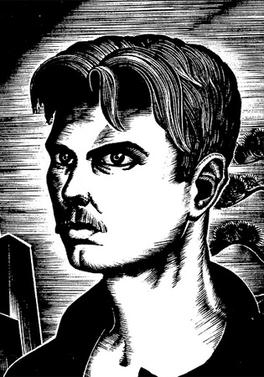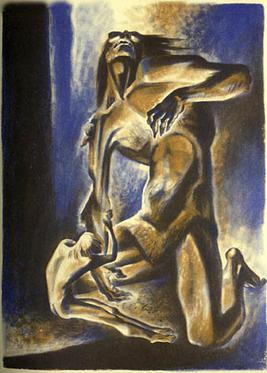Lynd Ward facts for kids
Quick facts for kids
Lynd Ward
|
|
|---|---|

1930 self portrait
|
|
| Born |
Lynd Kendall Ward
June 26, 1905 |
| Died | June 28, 1985 (aged 80) Reston, Virginia, U.S.
|
| Nationality | American |
| Education |
|
| Known for |
|
| Spouse(s) | May McNeer |
Lynd Kendall Ward (born June 26, 1905 – died June 28, 1985) was an American artist and writer. He is famous for his special "wordless novels." These books tell a story using only pictures, mostly wood engravings, without any words.
Ward also drew pictures for many children's and adult books. His wordless novels helped shape what we now call graphic novels. Besides wood engravings, he also worked with watercolors, oil paints, and other art styles. His most well-known books are Gods' Man and The Biggest Bear, which won an award.
Contents
Early Life and Art
Lynd Kendall Ward was born in Chicago, Illinois, on June 26, 1905. His father, Harry F. Ward, was a minister and social activist. His mother was Harriet May "Daisy" Kendall Ward.
When Lynd was very young, he had some health challenges. To help him get better, his family moved to different places, including Canada and Oak Park, Illinois.
Ward loved art from a young age. He decided to become an artist when his first-grade teacher told him that "Ward" spelled backward is "draw"! He learned linoleum-block printing in high school. He graduated with honors in art in 1922.
Ward then studied fine arts at Teachers College, Columbia University in New York. There, he met May Yonge McNeer, and they got married in 1926.
After their wedding, they traveled to Europe. They spent a year in Leipzig, Germany. Ward studied at the National Academy of Graphic Arts and Bookmaking. He learned different art techniques, especially wood engraving. In Germany, he discovered "wordless novels" by artists like Frans Masereel. These books told stories only through pictures. This discovery greatly inspired Ward.
Starting His Career
Ward returned to the United States in 1927. He soon began illustrating books. His first big project was for The Begging Deer in 1928. His wife, May, often helped him with research for his drawings. She also wrote children's books that Ward illustrated, like Prince Bantam.
In 1929, Ward was inspired to create his own wordless novel after seeing a book by German artist Otto Nückel. Ward's first wordless novel, Gods' Man, came out in October 1929. This was the first American wordless novel. Even though it was published right before the Wall Street Crash of 1929, it became very popular.
He went on to create five more wordless novels:
- Madman's Drum (1930)
- Wild Pilgrimage (1932)
- Prelude to a Million Years (1933)
- Song Without Words (1936)
- Vertigo (1937)
Ward also worked in many other art forms. These included watercolor, oil painting, and lithography. He illustrated over 100 children's books. Many of these were collaborations with his wife, May. Ward was known for his artwork that often explored themes about fairness and people's lives.
Awards and Recognition
Ward won many awards for his amazing artwork. He received a Library of Congress Award for his wood engravings. In 1953, he won the famous Caldecott Medal for his book The Biggest Bear. This award is given to the artist of the most distinguished American picture book for children.
He also illustrated two books that won the Newbery Medal. This award is for the best American children's book. In 2011, he was chosen for The Will Eisner Award Hall of Fame. This honor recognizes great comic book artists.
Since 2011, the Lynd Ward Graphic Novel Prize has been given out each year. This award celebrates the best graphic novel or comic book by a living artist from the U.S. or Canada.
His Unique Wordless Novels
Ward is most famous for his wordless novels. These books tell a complete story using only dramatic wood engravings. His first book, Gods' Man (1929), uses a mix of Art Deco and Expressionist styles. It tells the story of an artist's journey and challenges.
Ward was inspired by European artists like Frans Masereel and Otto Nückel. His books, especially Gods' Man, had a big impact on later artists and writers.
Ward was working on another wordless novel when he passed away in 1985. Twenty-six of his completed wood engravings from this unfinished book were published in 2001.
Other Illustrated Works
Ward's wood engravings were used in many different books. He illustrated travel books and classic stories like Mary Shelley's Frankenstein.
He also illustrated popular children's books. These include The Little Red Lighthouse and the Great Gray Bridge (1942) and Johnny Tremain. In 1973, he created a wordless story for children called The Silver Pony. This book uses only black, white, and gray painted pictures.
Ward's work sometimes showed the unfairness people faced in the United States. For example, in The Silver Pony, he included characters from different backgrounds, like African American and Native American children.
He also illustrated several books written by his wife, May McNeer. These include Little Baptiste and My Friend Mac.
In 1974, a book called Storyteller Without Words was published. It included all six of Ward's wordless novels. For this book, Ward himself wrote short introductions to each of his works.
Later Life
Lynd Ward retired in 1979 and moved to Reston, Virginia. He passed away on June 28, 1985, just two days after his 80th birthday. His amazing art continues to inspire many people today.
See also
 In Spanish: Lynd Ward para niños
In Spanish: Lynd Ward para niños



